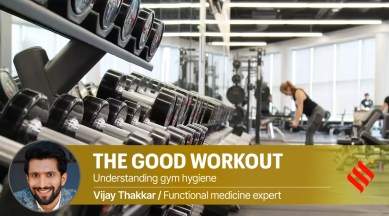Walk for 45 minutes indoors in your loungewear and with music: What’s a Cozy Cardio workout all about?
This fitness at home mantra, while transitioning from sedentary to an active lifestyle, has gone viral. Vijay Thakkar, functional medicine expert and celebrity fitness coach, weighs the pros and cons

New trends continuously surface in the ever-adapting realm of fitness, reshaping our understanding of well-being. One such shift is ‘cosy cardio’ or making cardio exercises enjoyable and accessible daily. Basically, these are exercises that you can do at home and blend them with your activity patterns. The idea is to take away the tedium of taking out a cardio hour for the gym and make it look like another box to be ticked. These sessions could take the form of indoor walking, stair-climbing, cleaning workouts, shadow boxing or jumping ropes.
What is cosy cardio?
monthly limit of free stories.
with an Express account.
Cosy cardio promotes indoor walking on a pad, eliminating challenges like rugged terrains or unpredictable weather. You could do that for 45 minutes in your loungewear while watching television or listening to background music. Hope Zuckerbrow created this approach amid her struggles with a complex fitness journey. Wanting an accessible, comfortable yet effective workout, she combined calming ambience elements like coloured lights and candles with slow walks on her pad, birthing cosy cardio. Her vision was clear: create a fitness routine that’s both accessible and effective, bridging the chasm between sedentary lifestyles and intense workouts.
A boon for beginners
For fitness newcomers, diving straight into intense exercises is daunting. Cosy cardio simplifies this transition. Instead of instantly reaching peak activity, it allows beginners to gradually build up, aligning with the World Health Organisation’s recommendation of 150 minutes of moderate-intensity aerobic exercise weekly.
Consistency is critical, and cosy cardio’s simplicity fosters this. Zuckerbrow transitioned from 20-minute walks at 4 kmph to longer, inclined sessions at increased speeds.
Additionally, research supports the benefits of even low-intensity physical activity. A study in 2018 highlighted a 24 per cent drop in cardiovascular mortality and 11 per cent reduction in all-cause mortality when replacing 30 sedentary minutes with light exercise. A 2019 study noted the positive impacts of low-intensity activities on heart rate and hypertension management, especially beneficial for those with chronic conditions. Furthermore, exercises like cosy cardio release endorphins and norepinephrine, neurotransmitters essential for mood regulation.
Limited in the long run?
Despite its merits, cosy cardio has its ceiling. Our bodies, over time, adapt to exercise routines, reducing their effectiveness. The American College of Sports Medicine emphasises that continuous engagement with the same activity level can cause fitness benefits, such as improved heart and lung functions, to plateau. Progressing in intensity becomes crucial to sustain health benefits.
What’s a holistic routine?
A holistic fitness journey transcends cosy cardio. Activities like outdoor running provide greater intensity and expose us to sunlight – a natural vitamin D source. According to a study in Occupational and Environmental Medicine, thrice-weekly outdoor exercises can decrease the dependency on medications for blood pressure, mental health and asthma by significant percentages of 36, 33 and 26 per cent, respectively.
Moreover, solely practising cosy cardio might limit social interactions, which, as the American Heart Association notes, play a pivotal role in reducing mortality risks from heart ailments. Social interactions reduce hospitalisation rates in older adults and provide a psychological boost. Engaging in physical activities such as walks with peers diverts from anxiety-inducing thoughts, making exercise sessions more enjoyable.
Integrating cosy cardio with other fitness forms like yoga, Pilates, and strength training ensures comprehensive health engagement.
Cosy cardio, while innovative, should be viewed as a foundation. Achieving optimal fitness requires a blend of consistency, progression and diversification. While the allure of cosy cardio is undeniable, we must continue evolving our fitness regimes to keep our bodies optimally challenged, engaged and primed for health.
(Vijay Thakkar is a functional medicine expert and celebrity fitness coach in Mumbai. He is author of the book “Eating Less is Making You Fat,” aimed at dispelling misinformation about nutrition, calorie-deficit diets, metabolism and how hunger and satiety work)